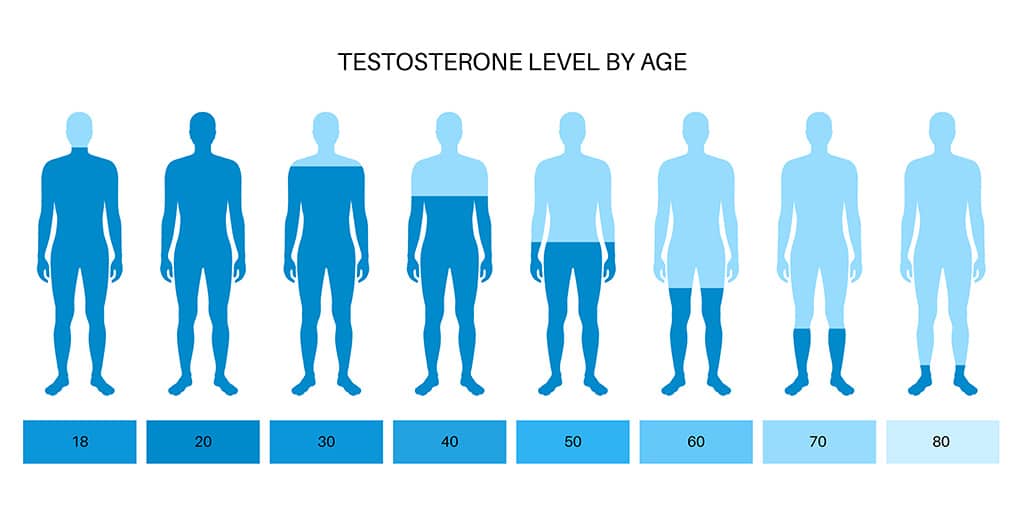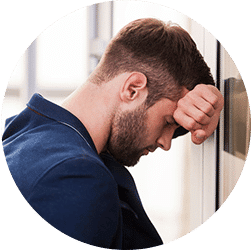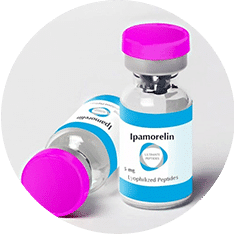
Unlock a More Youthful You With Testosterone Replacement Therapy In Lower Manhattan, NY
Aging is inevitable, and for many, it signals the beginning of a new chapter - one where you cross off bucket list items and live life to the fullest, on your own terms. However, for some men, aging is a horrible prospect, filled with chronic fatigue, irritability, and inability to perform in the bedroom. If you're concerned about life in middle age and beyond, we've got great news: there are easy, proven steps that you can take to help stop the negative effect of aging.
Global Life Rejuvenation was founded to give men a new lease on life - one that includes less body fat, fewer mood swings, and more energy as you age. If you're ready to look and feel younger, it's time to consider TRT (testosterone replacement therapy), and growth hormone peptides. These therapies for men are effective, safe, and customized to fit your goals, so you can keep loving life as you get older.
TRT, and growth hormone peptide therapies bridge the gap between your old life and the more vibrant, happier version of you. With a simple click or call, you can be well on your way to a brighter future. After all, you deserve to be the one in charge of your wellness and health. Now, you have the tools to do so - backed by science and applied by our team of TRT and HRT experts with more than 13 years of experience.

Testosterone Replacement Therapy
- Unlock A More Youthful You With Testosterone Replacement Therapy In Lower Manhattan, NY
- TRT and Anti-Aging Medicine for Men
- Common Symptoms of Low Testosterone
- Benefits of TRT and Anti-Aging Medicine for Men
- Fight Back Against Male Menopause
- Reverse Aging with Growth Hormone Peptides in Lower Manhattan, NY
- Your New, Youthful Lease on Life Starts Here
TRT and Anti-Aging Medicine for Men in Lower Manhattan, NY
For men, getting older comes with its perks, like living life on their own terms and not having to "sweat the small stuff" day in and day out. At the same time, there are aspects of aging that men dread, like hormonal changes. Yes, you read that right – men, not just women, go through hormonal changes as they age. For men, the biggest change involves a drop in testosterone.
Lower levels of testosterone can wreak havoc on a male's mind and body and when left untreated, can result in symptoms like:
- Erectile Dysfunction
- Depression
- Irritability
- Low Sex Drive
- Hair Loss
- Less Muscle Mass
- Problems Concentrating
Those symptoms are concerning, but with testosterone replacement therapy and anti-aging medicine, many males improve their quality of life with age. The good news is that TRT and anti-aging meds aren't only reserved for "old guys." In fact, there's no magic age at which men should start thinking about hormone replacement therapy. Everyone's body is different, so if you're experiencing the above conditions in your mid-30s, TRT could be a viable solution when you consult with a doctor.


What is Testosterone?
Testosterone is a crucial hormone for men and plays an important role throughout the male lifespan. Most of a male's testosterone is produced through the testicles. Also called the male sex hormone, testosterone starts playing its part during puberty.
When a male goes through puberty, testosterone helps males develop:
- Facial Hair
- Body Hair
- Deeper Voice
- Muscle Strength
- Increased Libido
- Muscle Density
As boys turn to men and men grow older, testosterone levels deplete naturally. Sometimes, events like injuries and chronic health conditions like diabetes can lower testosterone levels. Unfortunately, when a man loses too much T, it results in hypogonadism. When this happens, the testosterone must be replaced, or the male will suffer from symptoms like muscle loss, low libido, and even depression.

How Does TRT Work?
TRT is exactly what it sounds like: a treatment option for men that replaces testosterone so that your body regulates hormones properly and restores balance to your life. Also called androgen replacement therapy, TRT alleviates the symptoms that men experience with low T.
Originally lab-synthesized in 1935, testosterone has grown in popularity since it was produced. Today, TRT and other testosterone treatments are among the most popular prescriptions in the U.S.
Without getting too deep into the science, TRT works by giving your body the essential testosterone it needs to function correctly. As the primary androgen for both males and females, testosterone impacts many of the body's natural processes – especially those needed for overall health. For example, men with low T are more prone to serious problems like cardiovascular disease and even type-2 diabetes.
When your body quits making enough testosterone, it causes your health to suffer until a solution is presented. That's where TRT and anti-aging medicine for men can help. TRT helps balance your hormones and replenish your depleted testosterone. With time, your body will begin to heal, and many symptoms like low libido and irritability begin to diminish.

What Causes Low T?
For men, aging is the biggest contributor to lower testosterone levels, though there are other causes like obesity, drug abuse, testicular injuries, and certain prescribed medications. Sometimes, long-term health conditions like AIDS, cirrhosis of the liver, and kidney disease can lower testosterone levels.
When a man's testosterone levels drop significantly, it alters his body's ratio of estrogen and testosterone. Lower testosterone levels cause more abdominal fat, which in turn results in increased aromatase, which converts even more testosterone into estrogen.
If you're concerned that you might have low T, you're not alone. Millions of men in the U.S. feel the same way. The best way to find out if your testosterone is low is to get your levels tested.
For sustainable testosterone replacement therapy benefits, you must consult with hormone doctors and experts like those you can find at Global Life Rejuvenation. That way, you can find the root cause of your hormone problems, and our team can craft a personalized HRT plan tailored to your needs.
Common Symptoms of Low Testosterone
Are you used to blasting through a productive day and accomplishing all your daily goals? Do you find yourself losing muscle mass and the craving to be intimate with your partner? Does your partner complain about how irritable you have become? If you're not usually a curmudgeon, your body could be giving you a sign. It could be time to speak with a doctor about TRT and anti-aging medicine for men in Lower Manhattan, NY.
If you're experiencing any of the following symptoms, you might be battling against low testosterone:

Low Sex Drive
One of the most common reasons that men choose TRT is because they have lost that "spark" with their partner. It's not easy for a man to hear that they're not performing like they used to. Intimacy is a powerful part of any relationship. When a once-healthy sex life dwindles, it can cause serious relationship issues.
The good news is that low libido doesn't have to be a permanent problem. TRT and anti-aging medicines help revert hormone levels back into their normal range. When this happens, many men have a more enjoyable life full of intimacy and sex drive.

Inability to Achieve and Maintain an Erection
Weak erections – it's an uncomfortable subject for many men in the U.S. to talk about. It's even worse to experience first-hand. You're in the midst of an intimate moment, and you can't do your part. Despite being perfectly normal, many men put blame and shame upon themselves when they can't achieve an erection. And while the inability to perform sexually can be caused by poor diet, obesity, and chronic health conditions, low testosterone is often a contributing factor.
Fortunately, weak erections are a treatable condition. The best way to regain your confidence and ability in bed is to speak with your doctor. Once any underlying conditions are discovered, options like TRT may be the best course of treatment.
Hair Loss

Loss of Strength and Muscle Mass
Do you find it harder and harder to work out and lift weights in the gym? Are you having problems lifting heavy items that you once had no problem lifting?
Recent studies show that when men are inactive, they lose .5% of muscle strength every year, from ages 25 to 60. After 60, muscle loss doubles every decade. While some muscle loss is common as men age, a significant portion can be tied to low testosterone levels. When a man's T levels drop, so does his muscle mass.
Testosterone is a much-needed component used in gaining and retaining muscle mass. That's why many doctors prescribe TRT Lower Manhattan, NY, for men having problems with strength. One recent study found that men who increased their testosterone levels using TRT gained as much as 2.5 pounds of muscle mass.
Whether your gym performance is lacking, or you can't lift heavy items like you used to, don't blame it all on age. You could be suffering from hypogonadism.

Hair Loss
If you're like millions of other men in their late 20s and 30s, dealing with hair loss is a reality you don't want to face. Closely related to testosterone decline and hormone imbalances, hair loss is distressing for many men. This common symptom is often related to a derivative of testosterone called DHT. Excess amounts of DHT cause hair follicles to halt their production, causing follicles to die.
Because hair located at the front and crown is more sensitive to DHT, it grows slower than other follicles and eventually stops growing permanently. Thankfully, TRT and anti-aging treatments for men in Lower Manhattan, NY, is now available to address hair loss for good.
While it's true that you can't change your genes, you can change the effects of low testosterone on your body. Whether you're suffering from thinning hair or hair loss across your entire head, TRT and other hormone therapies can stop hair loss and even reverse the process.

Gynecomastia
Also called "man boobs," gynecomastia is essentially the enlargement of male breast tissue. This increase in fatty tissue is often caused by hormonal imbalances and an increase in estrogen. For men, estrogen levels are elevated during andropause. Also called male menopause, andropause usually happens because of a lack of testosterone.
If you're a man between the ages of 40 and 55, and you're embarrassed by having large breasts, don't lose hope. TRT is a safe, effective way to eliminate the underlying cause of gynecomastia without invasive surgery. With a custom HRT and fitness program, you can bring your testosterone and estrogen levels back to normal before you know it.

Decreased Energy
Decreased energy was once considered a normal part of aging. Today, many doctors know better. Advances in technology and our understanding of testosterone show that low T and lack of energy often go hand-in-hand.
If you're struggling to enjoy activities like playing with your kids or hiking in a park due to lack of energy, it could be a sign of low T. Of course, getting tired is perfectly normal for any man. But if you're suffering from continual fatigue, a lack of enjoyment, or a decrease in energy, it might be time to speak with a doctor.
Whether you're having a tough time getting through your day or can't finish activities you used to love, TRT could help.

Lack of Sleep
A study from 2011 showed that men who lose a week's worth of sleep can experience lowered testosterone levels – as much as 15%, according to experts. Additional research into the topic found almost 15% of workers only get five hours of sleep (or less) per night. These findings suggest that sleep loss negatively impacts T levels and wellbeing.
The bottom line is that men who have trouble sleeping often suffer from lower testosterone levels as a result. If you find yourself exhausted at the end of the day but toss and turn all night long, you might have low T.
TRT and anti-aging medicines can restore your T levels back to normal, which can help you sleep better with proper diet and exercise.

Depression
You're feeling down about everything, and there's no solid explanation for why you're in such a crummy mood. Your daily life is great and full of success, but you can't help but feel unexcited and unmotivated. If you're experiencing symptoms like these, you may be depressed – and it may stem from low testosterone.
A research study from Munich found that men with depression also commonly had low testosterone levels. This same study also found that depressed men had cortisol levels that were 67% higher than other men. Because higher cortisol levels lead to lower levels of testosterone, the chances of severe depression increase.
Depression is a very real disorder and should always be diagnosed and treated by your doctor. One treatment option gaining in popularity is TRT for depression. Studies show that when TRT is used to restore hormone levels, men enjoy a lighter, more improved mood. That's great news for men who are depressed and have not had success with other treatments like anti-depression medicines, which alter the brain's chemistry.

Inability to Concentrate
Ask anyone over the age of 50 how their memory is, and they'll tell you it wasn't what it used to be. Memory loss and lack of concentration occur naturally as we age – these aren't always signs of dementia or Alzheimer's.
However, what many men consider a symptom of age may be caused by low testosterone. A 2006 study found that males with low T levels performed poorly on cognitive skill tests. These results suggest that low testosterone may play a part in reducing cognitive ability. If you're having trouble staying on task or remembering what your schedule is for the day, it might not be due to your age. It might be because your testosterone levels are too low. If you're having trouble concentrating or remembering daily tasks, it could be time to talk to your doctor.
Why? The aforementioned study found that participating men experienced improved cognitive skills when using TRT.

Weight Gain
Even though today's society is more inclusive of large people, few adults enjoy gaining weight as they age. Despite their best efforts, many men just can't shed the extra pounds around their midsections, increasing their risk of heart disease and cancer.
Often, male weight gain is caused by hormone imbalances that slow the metabolism and cause weight to pile on. This phase of life is called andropause and happens when there is a lack of testosterone in the body. Couple that with high cortisol levels, and you've got a recipe for flabby guts and double chins.
Fortunately, TRT treatments and physician-led weight loss programs can correct hormone imbalances and lead to healthy weight loss for men.
Benefits of TRT and Anti-Aging Medicine for Men in Lower Manhattan, NY
The benefits of hormone replacement therapy for men are numerous. TRT not only grants relief from low-T symptoms but can help give protection against age-related diseases. Additionally, doctors now recognize male testosterone as an important role in alleviating depression.
Some of the most exciting benefits of TRT can include:
- Reduction in Body Fat
- Increased Strength
- More Muscle Mass
- More Energy
- Lower Risk of Erectile Dysfunction
- Higher Sperm Production
- Healthy Reproductive Tissues
- Lower Risk of Heart Disease and Diabetes
- Lower Risk of Anxiety
- Lower Risk of Depression


Fight Back Against Male Menopause
Because men do not go through a specific period of hormonal changes like women do (called menopause), many doctors refer to "male menopause" as androgen decline. This is just another term for low testosterone, but like female menopause, the symptoms can be serious and affect your quality of life.
The best way to fight back against male menopause is with male HRT treatment from Global Life Rejuvenation. We provide the following HRT treatments for men:
- Testosterone Replacement Therapy (TRT)
- Sermorelin (Sermorelin Acetate)
- Human Growth Hormone (HGH)
Our treatment options are personalized for your body and are available as creams, gels, injectables, and implantable pellets. To find out if testosterone replacement therapy is safe for you, contact Global Life Rejuvenation today to schedule your comprehensive testing and anti-aging treatment consultation.
Reverse Aging with Growth Hormone Peptides in Lower Manhattan, NY
Growth hormone peptides are an innovative therapy that boosts the natural human growth hormone production in a person's body. These exciting treatment options help slow down the aging process and give you a chance at restoring your youth.

What is Sermorelin?
Sermorelin is a synthetic hormone peptide, like GHRH, which triggers the release of growth hormones. When used under the care of a qualified physician, Sermorelin can help you lose weight, increase your energy levels, and help you feel much younger.

Benefits of Sermorelin
Human growth hormone (HGH) therapy has been used for years to treat hormone deficiencies. Unlike HGH, which directly replaces declining human growth hormone levels, Sermorelin addresses the underlying cause of decreased HGH, stimulating the pituitary gland naturally. This approach keeps the mechanisms of growth hormone production active.
Benefits of Sermorelin include:
- Better Immune Function
- Improved Physical Performance
- More Growth Hormone Production
- Less Body Fat
- Build More Lean Muscle
- Better Sleep

What is Ipamorelin?
Ipamorelin helps to release growth hormones in a person's body by mimicking a peptide called ghrelin. Ghrelin is one of three hormones which work together to regulate the growth hormone levels released by the pituitary gland. Because Ipamorelin stimulates the body to produce growth hormone, your body won't stop its natural growth hormone production, which occurs with synthetic HGH.
Ipamorelin causes growth hormone secretion that resembles natural release patterns rather than being constantly elevated from HGH. Because ipamorelin stimulates the natural production of growth hormone, our patients can use this treatment long-term with fewer health risks.

Benefits of Ipamorelin
One of the biggest benefits of Ipamorelin is that it is suitable for both men and women. It provides significant short and long-term benefits in age management therapies, boosting patients' overall health, wellbeing, and outlook on life. When growth hormone is produced by the pituitary gland using Ipamorelin, clients report amazing benefits.
Some of those benefits include:
- Powerful Anti-Aging Properties
- More Muscle Mass
- Less Unsightly Body Fat
- Deep, Restful Sleep
- Increased Athletic Performance
- More Energy
- Less Recovery Time for Training Sessions and Injuries
- Enhanced Overall Wellness and Health
- No Significant Increase in Cortisol
Your New, Youthful Lease on Life Starts Here
Whether you are considering our TRT services, HRT for women, or our growth hormone peptide services, we are here to help. The first step to turning back the hand of time starts by contacting Global Life Rejuvenation.
Our friendly, knowledgeable TRT and HRT experts can help answer your questions and walk you through our procedures. From there, we'll figure out which treatments are right for you. Before you know it, you'll be well on your way to looking and feeling better than you have in years!
 866-793-9933
866-793-9933
Request a Consultation
Latest News in Lower Manhattan, NY
Free Things to Do in New York, Every Day of the Week
Danielle Dowlinghttps://www.nytimes.com/article/free-events-nyc.html
New York is expensive, it’s true. But on any given day, you can enjoy art without spending a dime.Some museums offer free admission every day or on specific days. Others, like the Metropolitan Museum of Art, allow New York State residents to pay what they wish. (Most institutions either strongly encourage or require advance tickets, so check their websites before you go.)Plus, there are a handful of events, fes...
New York is expensive, it’s true. But on any given day, you can enjoy art without spending a dime.
Some museums offer free admission every day or on specific days. Others, like the Metropolitan Museum of Art, allow New York State residents to pay what they wish. (Most institutions either strongly encourage or require advance tickets, so check their websites before you go.)
Plus, there are a handful of events, festivals and concert series that are free in the summer or throughout the year. Here are some of our favorites.
Free Every Day
American Folk Art Museum
Folk art has demanded much more respect lately, not least of all because of the American Folk Art Museum’s dedication to the genre for more than 60 years. A visit to the institution will make you wonder why these works were relegated to art’s margins. Works by Martín Ramírez, Bill Traylor, Henry Darger and Thornton Dial are popular.
The Bronx Museum of the Arts
Because of this museum’s growing popularity, its $21 million expansion plan is hardly surprising. All the while, the museum has maintained its commitment to enhancing the local community through its contemporary art programming. The first part of the Sixth AIM Biennial, which will exhibit works by 53 emerging artists, is on view through March 31.
The High Line
From Gansevoort and Washington Streets to 34th Street between 11th and 12th Avenues, Manhattan; thehighline.org.
An old railway that was transformed into an elevated park, the High Line not only offers visitors a place to relax and take in some impressive city views, it’s also home to a rotating collection of public art, which appears at various points along the 1.45-mile promenade. Recent commissions include Pamela Rosenkranz’s “Old Tree” and Cosima von Bonin’s “What if They Bark?”
New York Public Library
Various locations throughout Manhattan, Staten Island and the Bronx; nypl.org.
Most branches of the New York Public Library host an astounding array of programs, ranging from artist talks to computer workshops. Three in particular — the Stephen A. Schwarzman Building in Midtown, the Library for the Performing Arts at Lincoln Center and the Schomburg Center for Research in Black Culture in Harlem — offer exhibitions. Chief among them is the ongoing “Treasures” at the Schwarzman Building, where you can marvel at objects from the library’s vault, such as a medieval girdle book and Thomas Jefferson’s handwritten copy of the Declaration of Independence.
Queens Museum
Flushing Meadows Corona Park, Queens; queensmuseum.org.
This museum’s “Panorama of the City of New York,” a model of the five boroughs in painstaking miniature, is a wonder to behold for out-of-towners and native New Yorkers alike. The institution is also known to host world-class exhibitions.
Socrates Sculpture Park
In 1986, the artist Mark di Suvero, along with local community members, turned an abandoned landfill into a public art space. Today, the five-acre grounds constitute the only municipal park in the city solely dedicated to the work of contemporary artists like Jeffrey Gibson and Dread Scott. The Socrates Annual, featuring pieces by Ashley Harris and the park’s five other 2023 fellows, is on view through March.
Free on Specific Days
Queens Botanical Garden
A multimillion dollar expansion plan that includes a new education center is in the works for this 39-acre landscape in Flushing. From April to October, on Sundays from 9 to 11 a.m. and on Wednesdays from 3 to 6 p.m., admission is free; from December to March, it is free all day, every day.
Open Mic
Brooklyn Comedy Collective, 167 Graham Avenue, Brooklyn; brooklyncc.com.
Filling the gap the Upright Citizens Brigade left open when it shuttered in 2020, the Brooklyn Comedy Collective offers an opportunity every Tuesday at 8:30 p.m. for amateur comedians looking to hone their craft alongside pros. Donations are suggested for the group’s diversity scholarship fund.
Bronx Zoo
This 265-acre park is the largest urban zoo in the United States. To see the more than 10,000 animals who live here, visit on a Wednesday, when admission to the grounds is free. You need to make an advance reservation online, which you can do by going to the Wednesday Bronx Zoo Tickets Store anytime after 5 p.m. on the Monday before your visit. And if you are feeling super ambitious, check out the New York Botanical Garden nearby, which is free to everyone on Wednesdays from 10 to 11 a.m., and to New York City residents all day.
The Brooklyn Children’s Museum
One of the few places where children are actually allowed to touch some of the art (and enjoy multiple hands-on play areas), this museum has been delighting families for decades. The institution offers free admission every Thursday from 2 to 5 p.m.
Frick Madison
The Frick Collection, a mainstay of old masters paintings and European fine and decorative arts, is an institution defined by the intimacy of its viewing experience, a feeling that is recreated in its temporary location, where it’s spending its last weekend. Admission to the museum is pay what you wish on Thursdays from 4 to 6 p.m.
New Museum
This institution is known for featuring the art world’s most promising up-and-comers and its most adventurous boundary pushers. Judy Chicago’s exhibition, “Herstory,” is on view through March 3. Admission on Thursdays from 7 to 9 p.m. is pay what you wish.
Other options for Thursday: International Center of Photography in Manhattan (pay what you wish, with a $5 minimum) and Wave Hill in the Bronx (free).
Sometimes it’s easy to overlook treasured, bespoke collections, like the ones at the Morgan. What began as a library now houses items from nearly every medium, from ancient to modern works. See them for yourself on a Friday from 5 to 7 p.m., when the museum offers free admission to the public.
Museum of Modern Art
On the first Friday of every month, MoMA remains open to everyone from 4 to 8 p.m. and offers free admission to New York City residents. It may take more than one visit to thoroughly explore the museum, though. Since its 2019 expansion, it has about twice the amount of modern and contemporary art on view. Tickets must be reserved in advance on MoMA’s website and are limited to two adults per reservation.
Neue Galerie
Renowned for its collection of early-20th-century German and Austrian art, including must-see pieces by the artist Gustav Klimt, this institution offers free admission on the first Friday of every month from 5 to 8 p.m.
Poster House
Devoted to one of the most accessible forms of art, this institution stays open until 9 p.m. and is free to the public on the first Friday of every month. In addition to its exhibitions, visitors can enjoy workshops, performances and a happy hour.
Rubin Museum of Art
From 6 to 10 p.m., the Rubin’s K2 Friday Night series offers not only free admission, but other activities, including exhibition tours and a D.J. and drinks at its cafe.
Other pay-what-you-wish options for Friday: New-York Historical Society and Whitney Museum of American Art in Manhattan.
First Saturdays, a beloved tradition at the museum that takes place every month between 5 and 11 p.m., raises the idea of community to a whole new level. It transcends the act of making art accessible to all and celebrates everything that represents Brooklyn through myriad cultural activities.
Solomon R. Guggenheim Museum
1071 Fifth Avenue, New York; guggenheim.org.
Apart from being an architectural wonder, the Guggenheim exhibits the city’s most impressive and intriguing collections of modern and contemporary art. On Saturdays from 6 to 8 p.m., visitors can pay what they wish to see the museum’s selections.
The Jewish Museum
This museum has the largest collection of work dedicated to Jewish culture in the country. On Saturdays, as well as select Jewish holidays, it offers free admission.
Art and Museums in New York City
Firefighters latest group to ask MTA for NYC congestion pricing exemptions
Evan Simko-Bednarskihttps://www.nydailynews.com/2024/03/01/firefighters-ask-mta-for-nyc-congestion-pricing-exemptions/
On-the-job firefighters using their personal vehicles to move equipment around the city shouldn’t be charged under the state’s plan to toll motorists entering Midtown and lower Manhattan, representatives of FDNY unions said Friday.“On every single day, 2,300 firefighters go to work in New York City,” Uniformed Firefighters Association president ...
On-the-job firefighters using their personal vehicles to move equipment around the city shouldn’t be charged under the state’s plan to toll motorists entering Midtown and lower Manhattan, representatives of FDNY unions said Friday.
“On every single day, 2,300 firefighters go to work in New York City,” Uniformed Firefighters Association president Andrew Ansbro said at a public comment session held at MTA headquarters. “When they get to their firehouse, they may be reassigned to another firehouse based on staffing needs — it happens probably a couple hundred times a day.”
Those firefighters then use their personal vehicles to move up to 80 pounds of equipment to their assigned location, Ansbro added.
“Our members would be crossing in and out of the congestion zone as they go from one firehouse to the next,” he said.
Ansbro was one of several firefighters who addressed the MTA at the second of four public comment sessions aimed at refining the agency’s plan to charge motorists under the state’s congestion pricing plan.
The current version of the plan would see a base toll of $15 levied once a day on cars and other small vehicles entering Manhattan at 60th St. and below.
That fee would be an unfair burden on firefighters who don’t know where they and their equipment would be needed each day, Ansbro argued.
“I don’t think anyone here thinks it’s safe for a New York City firefighter to carry that bag from the firehouse down to the subway, in the subway, up and out — an hour-and-a-half Crossfit session — and then show up at a firehouse and be expected to fight a fire at full capacity,” he said.
“The best tool on a fire truck is a well-rested firefighter.”
Jim Brosi, head of the Uniformed Fire Officers Association, agreed.
“This is a very unique department that has some very stringent requirements on how we transport personal protective gear,” he said. “We are required to use our personal car or public transportation.
“It is unrealistic that we should be expected to walk several city blocks before traveling two, three or four flights down below grade,” Brosi continued. “To then come back out of that hole and then be asked to perform firefighting duties immediately upon arrival at a firehouse is unrealistic.”
The MTA — along with the Traffic Mobility Review Board, the body that suggested the current tolling plan — has generally pushed back against requests for exemptions by public servants and others commuting by car.
But MTA chair Janno Lieber said Friday he was “sympathetic” to the firefighters’ arguments.
“They’re not asking for special treatment because they commute with their cars,” Lieber told reporters. “When they’re called upon to actually turn their personal vehicle into a city vehicle for the transportation of gear, that ought to be thought through.”
Still, Lieber stopped short of backing an exemption, saying the city should bear the cost instead of smoke-eaters themselves.
“We’re still in discussions with the city about [municipal] work vehicles and how to define them,” Lieber said.
“I think this is a classic situation where the employer is asking an employee to turn [a] personal vehicle into a work vehicle,” he said. “Normally, when an employer says you’ve got to travel a certain way to carry equipment or to carry material, they compensate you for the cost of that.”
Congestion pricing is expected to raise $1 billion per year in revenue towards the MTA’s capital budget.
The controversial policy is on schedule to be put into effect in June, pending legal challenges from the state of New Jersey and several groups of New York City residents.
The MTA said 72 people spoke at Friday’s hearing. Counting the 89 people who spoke at the first congestion pricing, the MTA said, it had heard from a total of 161 speakers about the issue. Two more hearings are planned, both on Monday.
MTA gives congestion pricing update ahead of first public hearing
Andrew Siffhttps://www.nbcnewyork.com/traffic/transit-traffic/congestion-pricing-nyc-manhattan-how-it-works/5177568/
The MTA announced Wednesday that 95% of the toll readers for its controversial congestion pricing program have been installed, covering 104 of the planned 110 locations.Cars will be charged an additional $15 to enter Manhattan at 61st Street and below, while trucks could be charged between $24 and $36, depending on size. As it stands, the collection readers are scheduled to go "live" on or about June 15. MTAMTA Chairman Ja...
The MTA announced Wednesday that 95% of the toll readers for its controversial congestion pricing program have been installed, covering 104 of the planned 110 locations.
Cars will be charged an additional $15 to enter Manhattan at 61st Street and below, while trucks could be charged between $24 and $36, depending on size. As it stands, the collection readers are scheduled to go "live" on or about June 15. MTA
MTA Chairman Janno Lieber said Wednesday it’s “highly probable” that MTA will prevail in lawsuits on both sides of the Hudson and that the tolling program can begin as scheduled.
The MTA update comes a day before the first of four hearings, virtual and in-person, where the public will have the opportunity to comment on the proposed plan and suggest amendments before a final vote in the spring.
The hearings will be held on the 20th floor of 2 Broadway in Manhattan. There will also be a Zoom option.
Members of the public who want to speak at the hearings have to register in advance online or by calling 646-252-6777. Registration is now open, and closes 30 minutes after the start of the hearings.
The public can also send a written or audio comment through one of these methods:
Online: https://contact.mta.info/s/forms/CBDTP Email: [email protected] Mail: CBD Tolling Program, 2 Broadway, 23rd Floor, New York, NY 10004 Phone: 646-252-7440 Fax: Send to (212) 504-3148 with Attention to CBDTP Team.
The hearings will be streamed on the MTA's website.
The MTA board overwhelmingly voted to approve the measure in December, saying charging drivers to enter a large swath of Manhattan would contribute millions of dollars to the city's aging transit system.
The approval came after the Traffic Mobility Review Board delivered its report to the MTA on Nov. 30, laying out the general guidelines for the impending tolls, including costs, when certain prices will be in effect, who gets credits and more.
Here's a breakdown of everything that was approved in December, and what comes next in the process.
News 4's Andrew Siff reports.
How does congestion pricing work? Who gets charged — and how much?
Congestion pricing would impact any driver entering what is being called the Central Business District (CBD), which stretches from 60th Street in Manhattan and below, all the way down to the southern tip of the Financial District. In other words, most drivers entering midtown Manhattan or below will have to pay the toll, according to the board's report.
All drivers of cars, trucks, motorcycles and other vehicles would be charged the toll. Different vehicles will be charged different amounts — here's a breakdown of the prices:
The $15 toll is about a midway point between previously reported possibilities, which have ranged from $9 to $23.
The full, daytime rates would be in effect from 5 a.m. until 9 p.m. each weekday, and 9 a.m. until 9 p.m. on the weekends. The board called for toll rates in the off-hours (from 9 p.m.-5 a.m. on weekdays, and 9 p.m. until 9 a.m. on weekends) to be about 75% less — about $3.50 instead of $15 for a passenger vehicle.
Drivers would only be charged to enter the zone, not to leave it or stay in it. That means residents who enter the CBD and circle their block to look for parking won't be charged.
Only one toll will be levied per day — so anyone who enters the area, then leaves and returns, will still only be charged the toll once for that day.
The review board said that implementing their congestion pricing plan is expected to reduce the number of vehicles entering the area by 17%. That would equate to 153,000 fewer cars in that large portion of Manhattan. They also predicted that the plan would generate $15 billion, a cash influx that could be used to modernize subways and buses.
An MTA fare increase is likely to come sooner than expected to public transportation. Tracie Strahan reports.
Do Uber, Lyft and other rideshares get exemptions? What about taxis?
There will be exemptions in place for rideshares and taxis, but much to their chagrin, they won't get away completely scot-free.
The toll will not be in effect for taxis, but drivers will be charged a $1.25 surcharge per ride. The same policy applies to Uber, Lyft and other rideshare drivers, but their surcharge will be $2.50.
New York Taxi Workers Alliance Executive Director Bhairavi Desai said in a statement that the plan is " a reckless proposal that will devastate an entire workforce."
Are there any other exemptions to congestion pricing tolls?
Many groups had been hoping to get exemptions, but very few will avoid having to pay the toll entirely. That small group is limited just to specialized government vehicles (like snowplows) and emergency vehicles.
Low-income drivers who earn less than $50,000 a year can apply to pay half the price on the daytime toll, but only after the first 10 trips in a month.
While not an exemption, there will also be so-called "crossing credits" for drivers using any of the four tunnels to get into Manhattan. That means those who already pay at the Lincoln or Holland Tunnel, for example, will not pay the full congestion fee. The credit amounts to $5 per ride for passenger vehicles, $2.50 for motorcycles, $12 for small trucks and $20 for large trucks.
Drivers from Long Island and Queens using the Queens-Midtown Tunnel will get the same break, as will those using the Brooklyn-Battery Tunnel. Those who come over the George Washington Bridge and go south of 60th Street would see no such discount, however.
Public-sector employees (teachers, police, firefighters, transit workers, etc.), those who live in the so-called CBD, utility companies, those with medical appointments in the area and those who drive electric vehicles had all been hoping to get be granted an exemption. But neither the MTA nor the Traffic Mobility Review Board included any such exemptions for those groups.
New Jersey is filing a lawsuit aimed at the Federal Highway Administration regarding the upcoming congestion pricing in NYC. Patricia Battle reporting.
So what comes next, and when will the tolls go into effect?
As for when the plan could go into effect, the MTA has maintained that the goal is to start charging the toll in late Spring 2024. But it's likely that will be delayed a bit.
Four public hearings will be held, starting Thursday, as part of a 60-day public response period. The last of those hearings is March 4. Any possible tweaks to the plan (like Mayor Eric Adams' request for more exemptions, for vehicles such as taxis) could be added before a "final" vote later in March or in April.
That would mean the earliest the tolls would go into effect would be late June 2024, at this point.
There had been fears of a toll as high as $23, but Lieber previously poured cold water on that idea, saying MTA board members were "trying to keep it well lower than that." He added that in order to keep the standard toll price low, the transit agency would have to keep the number of exemptions low as well.
Any one of the lawsuits filed against congestion pricing could also bring the plan screeching to a halt, depending on how the judges rule. Many of the challenges focus on the environmental impacts of the plan, though proponents have said it will help cut down on emissions.
Lieber said it's "highly probable" the transit agency will prevail in the lawsuits filed on both sides of the Hudson River, which would give them the green light to begin the program sometime in June, barring a surprise ruling from a judge.
How N.Y.’s ‘Good Cause Eviction’ Bill Breaks From Other States’ Laws
Greg Davidhttps://www.thecity.nyc/2024/02/28/good-cause-bill-could-blow-back-on-tenants/
Three words may determine whether Albany can pass legislation to deal with New York’s housing crisis, say tenant advocates and their allies in the legislature: Good cause eviction. Pass a version of our proposal and we will support tax breaks and other steps to build more housing, they say.But as the tenant groups ramp up their lobbying efforts and stage public demonstrations in support of the bill, the New York proposal differs substantially from similar measures elsewhere in the country — with Albany’s proposed ren...
Three words may determine whether Albany can pass legislation to deal with New York’s housing crisis, say tenant advocates and their allies in the legislature: Good cause eviction. Pass a version of our proposal and we will support tax breaks and other steps to build more housing, they say.
But as the tenant groups ramp up their lobbying efforts and stage public demonstrations in support of the bill, the New York proposal differs substantially from similar measures elsewhere in the country — with Albany’s proposed rent hike limit less than half of the 10% increases permitted in California and Oregon.
And a new policy brief, published Wednesday by the Furman Center at New York University, argues that the New York proposal is essentially an effort at extending rent regulation to free market apartments and will have unintended consequences that could have negative repercussions for tenants, especially in buildings with only a few units.
That could include giving landlords a benchmark for raising rent prices annually for all tenants, and discouraging development of new housing, making it even harder for renters to find affordable places to live, according to the report.
“The discussion in New York has tended to focus on protections that look more like an extension of rent regulation than the anti-gouging protections some other cities and states have adopted,” said Vicki Been, faculty director of the Furman Center and author of the paper. Been headed the city’s Department of Housing Preservation and Development under former Mayor Bill de Blasio.
Advocates for the bill, sponsored by Democratic state Sen. Julia Salazar of Brooklyn, reject that characterization.
The New York proposal, intended to discourage rent increases above 3% annually or more than 1.5 the rate of inflation, would create a guideline, not a cap, said Cea Weaver, campaign coordinator for the tenants’ movement Housing Justice for All and a prominent advocate for the bill.
If it were in effect in 2024, the proposed formula would point to rent hikes of no more than 4.2%. Landlords can move forward with raising rents more than that, she notes, but tenants can then challenge the increase in Housing Court. “That’s why it too is an anti-gouging law,” Weaver said.
Good cause laws are designed to limit the ability of landlords to refuse to renew leases, and most elsewhere in the country list specific reasons landlords may decline to renew, which always include if tenants do not pay rent. They also seek to limit huge rent increases which tenants might be unable to pay.
Furman estimates the Salazar bill would cover 710,000 apartments in the city.
A study by the New York Housing Conference of the proposal came up with a higher number — of almost 1 million units — but noted that as many as 480,000 are in buildings with three units or fewer. The bill exempts such buildings if they are owner-occupied, but no one knows how many fall into that category.
The Housing Conference also notes that the law primarily helps better-off New Yorkers. Renters in unregulated units earn more money than the typical tenant, median income of $62,900, above the citywide median of $50,000. They also pay higher rents, with a median $1,800 a month, which is $300 more than the median rent-stabilized tenant in the city.
New York Vs. The Country
While the New York law would exempt owner-occupied buildings with three units or less, other elements are more expansive than many good cause laws elsewhere. It would cover co-ops and condos that the owners rent out, which could total as many as 140,000 units, according to Furman. And it would include institutional buildings like dormitories.
Deciding whether the plan is an anti-gouging law or rent regulation in disguise depends on three areas of controversy: the size of annual rent increases, the impact on owners of smaller buildings, and the possibility that already clogged housing courts will see soaring caseloads.
The difference in allowed rent hikes between New York’s proposal and other states’ laws is striking. This year, California’s good cause eviction law will allow landlords to raise rents by a little less than 10% at maximum because it sets the allowable ceiling by using local consumer price index (CPI) plus 5 percentage points or 10%, whichever is less.
Oregon landlords also will be able to boost rents by 10% because it uses CPI plus 7 percentage points, or 10%.
New Jersey’s law has no statewide cap on increases, instead saying only that “unconscionable” rent increases are illegal. The definition of that word is left up to the courts.
The same would, in effect, be true in New York; judges would need to decide whether a landlord has raised rent too much.
Ellen Davidson, an attorney at the Legal Aid Society of New York and another active supporter of the bill, concurs with Weaver that it’s not a cap but a guideline that housing court judges can use to determine if a demanded rent increase is excessive.
The bill is a deliberate twist on the New Jersey law, according to advocates. “We kept the unreasonable rent increase concept but added guidance of how to think about the increase,” she said.
But lawyers for property owners say there is little resemblance between New York’s proposal and New Jersey’s law. “New Jersey has an anti-gouging law that says rent increases cannot be unconscionable, and that’s a very high legal standard,” said lawyer Sherwin Belkin, an expert on rent regulation who works with landlords.
Since many economists say rent regulation discourages new housing construction, other states have taken steps to limit the reach of good cause. California, for example, exempts any new building for 15 years after construction. Other states also require tenants to have at least a year residency before taking advantage of the law.
The Furman report is particularly worried about the impact on tenants in smaller buildings where the rents and annual increases are lower than in larger buildings and non-renewals less frequent. Given the limitations imposed by the law, small landlords might adopt the intensive screening of prospective tenants now used by almost all large landlords, and start to use the increase-limit guideline as a target for annual hikes, the Furman report says.
The report also suggests that the structure of the new law will further burden the city’s housing courts, where cases already drag on for months.
“Evictions and housing instability cause enormous harm to renter households,” said Been. “Proposals that require landlords to prove good cause for evicting a tenant or refusing to renew a lease are well-intentioned efforts to limit those harms. But they also simultaneously pose risks by discouraging investment in housing, raising costs for all tenants, and making it even harder for tenants to find a suitable home.”
Limited Research
One problem with the debate, experts say, is that the laws in other states are either new or their impact has not been extensively studied.
“There are such a small number of places that have implemented these programs we just don’t know much,” said Peter Hepburn, a sociologist and data scientist at Princeton University’s Eviction Lab. He noted that with the exception of one small study in California, there is no data on whether such bills actually reduce evictions.
And while the bills could help some tenants, he adds, the vast majority of eviction cases are for non-payment of rent, which every state allows as a legal cause.
Weaver says tenant advocates remain willing to negotiate a middle ground.
“We have been very clear that we are willing to have conversations in good faith about changes in the law and most laws that pass are a product of compromise,’’ she said.
But landlords, who say their finances have been devastated by pro-tenant provisions passed in 2019 sharply limiting increases in a million rent-regulated apartments in the city, contend that bringing good cause to New York would be a Trojan horse opening a path to further restrictions.
“There is a great fear and tremendous lack of trust of what the legislature will do,” said Belkin. “They pass an anti-rent gouging bill and somehow it morphs into a rent control bill.”
He Wanted a Studio in Lower Manhattan for Less Than $450,000. But Where?
Joyce Cohenhttps://www.nytimes.com/interactive/2023/11/23/realestate/23hunt-baxter.html
Aaron Baxter was happy in his rental in the NoLIta neighborhood of Lower Manhattan, with a view of Saint Patrick’s Old Cathedral.Mr. Baxter, who had lived primarily in Arizona and Colorado before moving to New York, landed a pandemic deal in late 2020, paying $2,500 a month for the nicely renovated one-bedroom — or maybe it was a studio with French doors to a sleeping area — in a prewar walk-up. There was a stacked washer and dryer in the bathroom.Friends who visited would say, “My walk-in closet is bigg...
Aaron Baxter was happy in his rental in the NoLIta neighborhood of Lower Manhattan, with a view of Saint Patrick’s Old Cathedral.
Mr. Baxter, who had lived primarily in Arizona and Colorado before moving to New York, landed a pandemic deal in late 2020, paying $2,500 a month for the nicely renovated one-bedroom — or maybe it was a studio with French doors to a sleeping area — in a prewar walk-up. There was a stacked washer and dryer in the bathroom.
Friends who visited would say, “My walk-in closet is bigger than this, and my mortgage is half your rent,” said Mr. Baxter, 51, a sales representative for a pharmaceutical company. “But I never needed a big place. I like the buzz of New York and the energy.”
A year ago, however, when he learned that his rent would jump by more than 75 percent, he decided that $4,400 for 350 square feet turned a good deal into a bad one. So he called a friend, Ian Matheson, a licensed salesman at Living New York, to help him find a new rental for no more than $3,500.
Because his landlord had given him several months’ notice about the increase, “I figured I had plenty of time to look,” he said. But he discovered that it was fruitless to hunt so far in advance, as departing renters typically give 30 days’ notice.
With some time to think, Mr. Baxter examined his finances and decided that buying was possible. He could spend up to $450,000.
[Did you recently buy a home? We want to hear from you. Email: [email protected]]
“When you’re in this starter-price range, apartments are all the same,” he said. “You’re going to get the same square footage, and it comes down to neighborhood.”
His preference was to stay in NoLIta or adjacent SoHo. He was hoping for in-unit laundry, but quickly realized that was unrealistic. And with leg and back problems stemming from a long-ago car crash, Mr. Baxter was hoping to avoid having too many stairs.
Early on, he wasn’t thinking much about an apartment’s condition. The first place he considered was a bare-bones co-op in the East Village for $399,000, with a monthly maintenance fee of $800.
“I am thinking: I am getting the steal of the century,” he said. “This can be done on the cheap, no big deal. This was a tiny apartment. How much could it possibly cost?”
There was no kitchen, and in the bathroom there was a hole in the floor. A contractor provided an estimate: The renovation would cost more than $75,000 — perhaps much more — and Mr. Baxter wouldn’t have a place to live during the months of work.
“I had no clue the thing had to be completely redone,” he said. “It was a good wake-up call.”
Fixer-uppers, he decided, were out. And he expanded his search area farther downtown.
Among his options:
SoHo Studio With Eat-in Kitchen
This sunny, centrally located studio was around 250 square feet, with an exposed-brick wall and high ceilings. It was on the fifth floor of a six-story walk-up, with an Italian restaurant on the ground level. There were two closets, a relatively large kitchen and a relatively small bathroom with a teacup sink. The asking price was $449,000, with monthly maintenance of just under $1,000.
This 450-square-foot studio was near Washington Square Park, on the fifth floor of a postwar land-lease building, meaning the co-op didn’t own the land underneath it, which could make the apartment difficult to finance or sell. It had a windowed kitchen, three closets and a Murphy bed. The building had an elevator, a laundry room and a communal garden. The price was $429,000, with monthly maintenance of around $1,550.
Financial District Studio in Doorman Building
This studio of around 450 square feet was in an unfamiliar neighborhood, but it was on a high floor in a converted 1926 office building with a doorman, a laundry room on every third floor and free storage. The apartment had a foyer, three closets and north-facing windows, as well as a nice, separate kitchen and a stall shower. The price was $428,000, with monthly maintenance of around $1,500.
Find out what happened next by answering these two questions:
Disclaimer:


